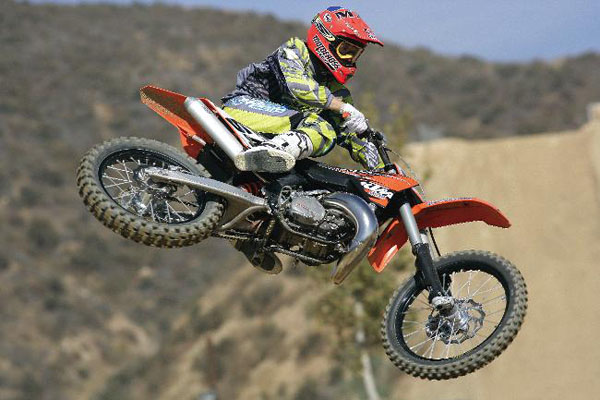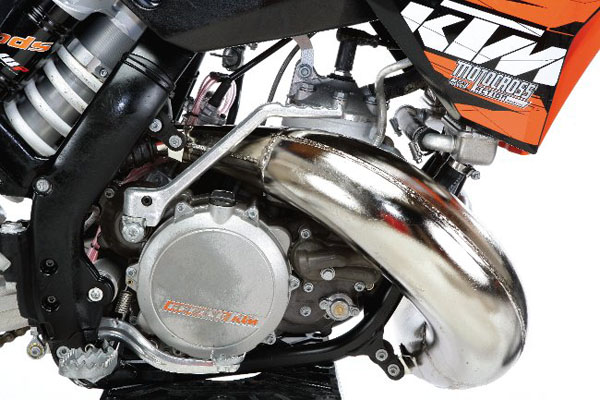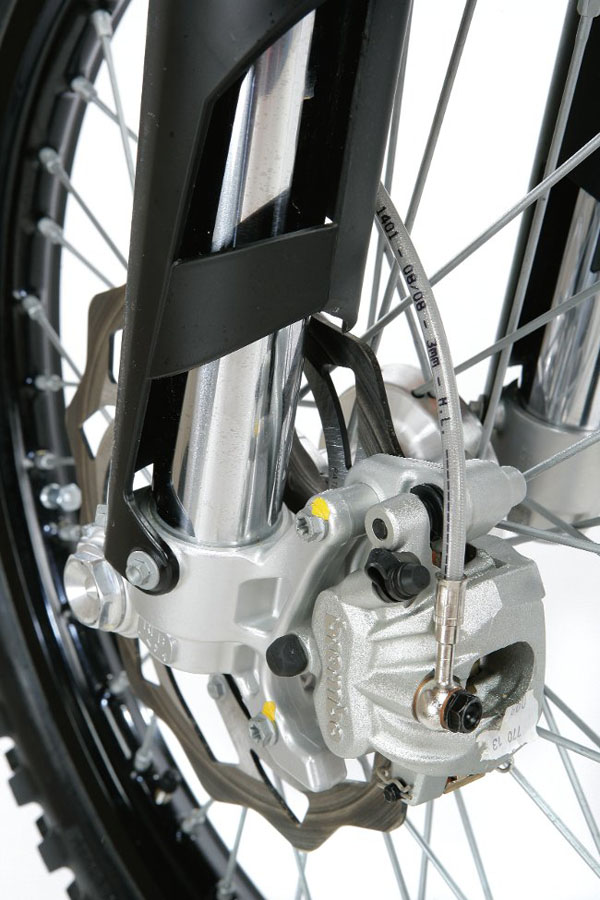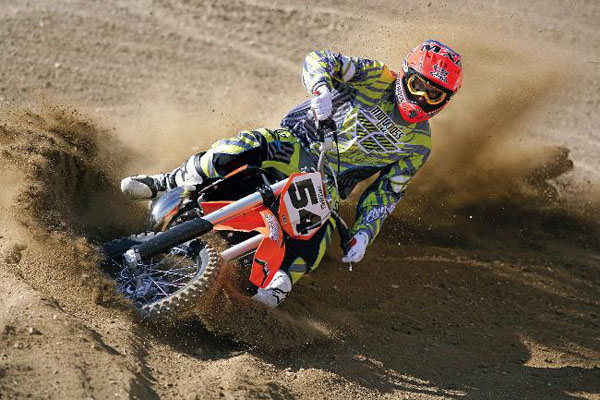Q: FIRST AND FOREMOST, IS THE 2010 KTM 250SX BETTER THAN THE 2009 KTM 250SX?
A: Yes. KTM has a reputation for making constant upgrades to their bikes. The 2010 KTM 250SX does not obsolete the 2009 model, but it is incrementally better.
Q: WHAT DID KTM CHANGE ON THE 250SX FOR 2010?
A: KTM has more different models of dirt bikes than any other manufacturer. So when they make changes to a new model, the changes can be broken down into two types. First, there are the “brand-specific” changes. These are mods made to every bike in the 2010 KTM stable. Second, there are the “model-specific” changes. These changes are made specifically to the 150SX, 250SX, 250SXF, etc.
Q: WHAT ARE THE MODEL-SPECIFIC CHANGES FOR THE 2010 250SX?
A: There were three KTM two-stroke-only changes.
(1) Cylinder. The 250SX cylinder head has been reinforced for more durability. Aside from the new graphics, the cylinder casting is the only visual clue indicating the difference between the 2010 and 2009 models.
(2) Radiator cap. The 2010 radiator cap has a 1.8 pressure rating. The 2009 250SX used a lower-boiling-point 1.4 rating. This doesn’t make the engine run cooler, but it makes the coolant boil at a higher temperature.
(3) Exhaust pipe. The pipe’s wall thickness has been increased from 0.88mm to 1.00mm to help rock-ding durability. Unfortunately, our expansion chamber was still dinged and dimpled after the first moto.
Q: WHAT ARE THE BRAND-SPECIFIC CHANGES MADE TO THE 2010 KTM 250SX?
A: There were six changes to the 2010 KTM 250SX that were also made to every other 2010 KTM.
(1) Triple clamps. KTM decided more flexibility was in order, so they redesigned the structure of the clamps, switched to two bolts instead of three bolts on the bottom clamp, and changed the offset from 20mm to 22mm (last year the KTM clamps could be switched between 20mm and 18mm positions, but for 2010 they are fixed at 22mm).

Feeling the breeze: The 250SX is 15 pounds lighter than its 450 brother. Thousands of dollars in titanium and carbon fiber doo-dads wouldn’t bridge that gap in weight. This is the lightest 250cc machine built.
(2) Forks. The WP forks have new seals and bushings to reduce stiction (static friction) and sliding friction.
(3) Airbox. KTM’s engineers put a lip around the top of the airbox to reduce the amount of dirt and water that might drip onto the air filter. Additionally, Twin Air designed a new filter for the 2010 bikes, but the old one still works.
(4) Brake pads. All the 2010 KTMs (save the 450SXF) get new Toyo B153 brake pads. These pads are less grabby and more progressive than last year’s pads. Half of the MXA test riders preferred the older pads because they were more powerful.
(5) Graphics. We hated last year’s cartoon graphics. They were too immature for a high-end, high-priced racing motorcycle. KTM has better graphics this year.
(6) Grips. A diamond pattern was added to the Renthal dual-compound grips.
Q: HOW DOES THE 2010 KTM 250SX RUN ON THE DYNO?
A: It’s a rocket ship! This is the most powerful 250cc motocross bike sold. On the dyno, the 2010 250SX made 49.05 horsepower at 8600 rpm and 30.95 foot pounds of torque at 8100 rpm.
For comparison purposes, here is how the 2010 KTM 250SX compares to the Honda CRF250, Honda CRF450 and Yamaha YZ250 two-stroke.
CRF250: The KTM 250SX makes 12.7 horsepower and 11 foot-pounds of torque more than the 2010 CRF250.
CRF450: The KTM 250SX makes 1.8 horsepower and 1.75 foot-pounds of torque less than the CRF450.
YZ250: The KTM 250SX makes 3.5 horsepower and two foot-pounds of torque more than the YZ250.
Q: HOW IS THE KTM 250SX POWERBAND?
A: By two-stroke standards, the 250SX has a very smooth, broad and usable powerband (very linear). The bike has just enough roll-on power off the bottom to glide through hardpacked turns, hook up in tippy-toe situations and help pull the engine into the meat of the powerband. The 250SX doesn’t hit hard down low, but when it comes on the pipe, it makes incredibly strong and usable power through the midrange.
Even though the KTM 250 two-stroke engine hasn’t seen any power improving modifications since 2008, every MXA test rider swore that the 2010 was broader than the 2009. We later discovered that we were running a softer power valve spring than we ran in 2009.
Q: WHAT ARE THE EASIEST WAYS TO CHANGE THE POWERBAND?
A: Before spending money on fancy mods, there are three things to try.
(1) Unplug the wire: There are two ignition curves in the black box. You can switch back and forth by unplugging the connector. In our opinion, unless you want the bike to feel slower, leave it plugged in on the aggressive curve.
(2) Power valve springs: There are two power valve springs supplied with the bike. The stiffer yellow spring, which comes in the bike, has a softer hit and revs through the powerband slower. The softer red spring hits harder and revs through the powerband quicker. We obviously liked the red spring.
(3) Silencer: If you’re ready to spend a little money, big gains can be made from mid-and-up with just a silencer. We have had good results with both the Pro Circuit and FMF PowerCore 2 silencer. We aren’t talking about improvements in decibels, but in horsepower.

Poetry: This simple engine design produces almost 50 horsepower (and that is achieved with 200cc less than a 450).
Q: HOW MUCH DOES THE 2010 KTM 250SX WEIGH?
A: Without fuel, the 2010 KTM 250SX hits the scales at 210.3 pounds. For comparison purposes, the 2010 KTM 250SXF four-stroke weighs 216.1 pounds, while the 450SXF is 230.6 pounds.
The 15-pound difference between the 250SX and 450SXF is huge and can be felt off the starting line, in the air, on the track and when picking up the bike.
Q: HOW GOOD ARE THE TIRES?
A: The old-school Bridgestone M59/M70 tire combo is something we would have chosen back in 1999 (when these tires were new). If we had our druthers, we’d opt for an M403/M404 combo for a better all-around performance package.
Q: HOW’S THE GEARING?
A: The 13/48 gearing complements the broad-feeling powerband and is ideal for carrying speed around fast turns. But most MXA test riders wanted more punch in the middle and swapped the 48 for a 49.
Q: HOW IS THE JETTING?
A: When we would stop and let the bike idle, it would get a little loaded up and feel rich. While riding, the bike ran smoothly. MXA’s recommended jetting is as follows:
Main: 158
Pilot: 40 (42 stock)
Needle: N1EI
Clip position: 3rd from top
Air screw: 1-1/2 turns
Notes: We turned the air screw in one-half turn when we installed an aftermarket silencer.
Q: HOW GOOD ARE THE WP FORKS?
A: Although KTM has taken little steps in the right direction every year, the WP forks are still a mystery. For some reason, the 450SXF forks are good, while the 250SXF forks are terrible. As you would expect, the 250SX forks fall somewhere in the middle. In the past, the MXA wrecking crew would lower the fork oil height by 20cc to lessen midstroke harshness. Unfortunately, KTM lowered the fork oil height 20cc on the production setting (without lessening midstroke harshness). We opted instead to run stiffer fork springs to hold the forks higher in their stroke (and also because the stock 0.44 springs are lighter than the springs in the 250SXF four-stroke)
Q: WHAT WERE OUR BEST FORK SETTINGS?
A: For hardcore racing we recommend this fork setup on the 2010 KTM 250SX:
Spring rate: 0.48 kg (0.44 kg/mm stock)
Oil height: 360cc
Compression: 7 clicks out (12 stock)
Rebound: 12 clicks out
Fork leg height: 5mm up
Notes: Thanks to new seals and bushings, the amount of stiction has been reduced (previously the WP forks had excessive static friction). If you switch to a firmer shock spring (which we recommend), the bike would be better balanced with the 0.48 kg/mm fork springs as well.
Q: HOW WAS THE WP PDS SHOCK?
A: KTM switched to a stiffer shock spring last year, and this year we decided to switch to an even stiffer shock spring (something we learned from working with the 450SXF). So, faster and bigger test riders went to a stiffer 7.6 kg/mm spring, but most opted for the 7.2 spring off the 450SXF. The stiffer springs required less preload, the WP shock felt free in the first part of the stroke and worked well through high-speed bumps. If you weigh less than 175 pounds, stick with the stock shock spring.

Pucker power: This Brembo/Galfer/Toyo combination is very powerful, yet easy to control. This is an awesome front brake.
Q: WHAT WAS OUR BEST SHOCK SETTING?
A: For hardcore racing we recommend this shock setup for the 2010 KTM 250SX:
Spring rate: 7.2 or 7.6 kg/mm (6.9 stock)
Race sag: 110mm
Hi-compression: 1 turn out (1-1/2 stock)
Lo-compression: 19 clicks out (15 stock)
Rebound: 15 clicks out (24 stock)
Note: Race sag can vary from 100mm to 110mm.
Q: HOW DID THE 2010 KTM 250SX HANDLE?
A: This isn’t your father’s four-stroke. It is amazing what a two-stroke can do that a four-stroke can only dream about. As a rule, all four-strokes take the same line because they are trying to maximize their torque advantage. Not so with the 250SX! Test riders could go wherever they wanted. They could cut across the inside of corners, go way outside in sweepers or jump out of ruts halfway around a bend.
Thanks to the lightweight and rapid throttle response, a KTM 250SX rider can change lines, pivot on a dime, hop out of ruts and take shortcuts that 450s couldn’t get to if they tried.
The downside of this agility is that any wheelspin can cost you drive.
Q: WHAT DID WE HATE?
A: The hate list:
(1) Gas tank. MXA hasn’t liked black plastic gas tanks since they were first introduced. And we don’t think that KTM’s engineers like them either, because for 2010 the XC models get semitransparent gas tanks. We want to know how much gas is in our bikes, too!
(2) Forks. WP has the potential to make great stuff, but WP’s setup has been hit and miss. Some models work well, while others stink. The 250SX forks are somewhere in no-man’s land.
(3) Handlebars. They are too low. Usually, the MXA test riders would just throw the stock bend away and mount their favorite bar, but this year we opted for the economical choice and got taller bar clamps from KTM’s parts catalog. These were about $25 versus handlebars at about $90.
Q: WHAT DID WE LIKE?
A: The like list:
(1) Brakes. When you add the dynamics of a 260mm Galfer rotor and the 250SX’s light weight, you can out-brake anyone on anything (except a KTM 150SX).
(2) Horsepower. KTM knows how to build engines. This is the fastest 250 two-stroke made.
(3) Psychological warfare. Most racers are accustomed to the low-pitched drone of thumpers behind them. Surprise! They find a shrieking two-stroke behind them nerve-wracking. We used the sound of the the KTM 250SX to disorient the guys in front of us.
(4) Hop-ups. Compared to its four-stroke brethren, the 250SX is an inexpensive bike to maintain and to hop-up.
(5) Sound. Under AMA rules, a 250cc two-stroke can make 96 dB, while a four-stroke can only make 94 dB (because the sound of a four-stroke carries twice as far as two-stroke sound). The KTM 250SX produced 94.5 dB, which is quieter than most four-strokes.
Q: WHAT DO WE REALLY THINK?
A: The box-stock 2010 KTM 250SX is a fast, lightweight and agile bike. It is surprisingly competitive against 450s and an unfair advantage over 250Fs. It is inexpensive to maintain and simple to work on. If the KTM 250SX doesn’t make you rethink the four-stroke revolution, nothing will.




